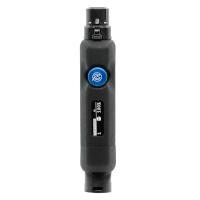
DMX Spy Pro
The ultimate pocket DMX troubleshooter is here, meet the DMX Spy Pro!
Send or receive DMX from this pocket sized handheld device.
Are you rigging a dimming pack? Wiring an LED decoder? Diagnosing a problematic DMX run? The DMX Spy Pro is a flexible tool that can do it all!
Overview
To navigate menus:
Click dial
To edit menu values:
Turn dial
DMX Spy Pro can both Receive - RX and Transmit - TX for ultimate flexibility.
To toggle between these two modes:
Hold dial for 1 second
The current mode is displayed in the top left corner (TX/RX). An arrow is displayed pointing to the active port on the device.
Power
To turn the device on:
Click dial
To turn the device off:
Hold dial for 3 seconds
Info
Device will auto sleep after 3 mins when no data is connected/device is not transmitting.
Receive DMX
Connect any DMX512 device via 5 pin XLR to view the level of your selected address.
The level of selected address will be displayed as a percentage (0-100%) and a decimal (0-255).
Tip
The input/output connectors of the DMX Spy Pro are connected together. Thus passthrough operation is possible.
Receive Modes
Analyse received data like never before, with 5 modes of analysis:
-
Heat Map
- Get an instant bird’s eye view of received data. Any address with a value above zero will illuminate.
- Ex: Quickly identify an incorrectly patched fixture.
-
Frequency
- Analyze the frequency of received data.
- Ex: Validate compatibility with a new data source.
-
Graph
- View how the selected data changes over time.
- Ex: Identify the cause of a stuttering lighting effect.
-
Monitor
- Detect any changes to the selected address.
- Ex: Check problematic data line for flickers/dropouts.
-
Status
- Review the health of received data.
- Ex: Ensure a new console is performing as expected.
Transmit DMX
DMX will be output on the address(es) determined by your transmit mode, at a level determined by your output pattern and level.
Transmit Modes
-
Single
- Output on the selected address only.
- Ex: Target a specific device
-
All
- Output on all DMX addresses.
- Ex: Test the status of every device
-
Range
- Output over an address range.
- START: First output address in your range.
- END: Last output address in your range.
- Ex: Diagnose a section of newly installed LED decoders
- Output over an address range.
-
Offset
- Output in multiples of your choosing, starting from a selected address.
- ADR: Starting address.
- MLT: Addresses will be selected in multiples of this number.
- Ex: Test a lift rigged with multiple sequential fixtures
- Output in multiples of your choosing, starting from a selected address.
-
Group
- Output in groups and easily shift to the next group in series.
- ADR: Starting address. Ex: Starting address of pack
- SIZE: Group size. Ex: SOCA Splay size (6)
- GROUP: Group to be selected for active output. Ex: SOCA splay number (1-2-etc)
- Ex: Flash through the output splays of a newly installed dimmer pack
- Output in groups and easily shift to the next group in series.
-
Record
- Output saved DMX snapshots.
- SLOT: Select between 3x storage slots (A, B, C)
- RECORD: Save incoming data into selected recording slot.
- CLEAR: Clear data stored in selected recording slot.
- Ex: Transmit work-light levels without a console
- Output saved DMX snapshots.
Output Patterns
Set intensity behaviour for transmitted data.
Solid
- Outputs at selected intensity
Wave
- Outputs an wave signal from 0% to selected intensity
Flash
- Outputs a flashing signal from 0% to selected intensity
Sequence
- Outputs a solid signal at selected intensity on incrementing addresses.
- Stepping sequence will loop once complete.
- Available in: Range, Offset, and Group modes.
Battery
The device charges via USB-C connector, and is compatible with most USB chargers.
Charging time from depleted is approximately 2hrs.
Battery Notifications
- Battery Low
- Battery Charging
- Battery Full
Tip
Remember to charge your tester before storing it for long periods of time to prevent battery degredation. A 50% charge is ideal for storage.